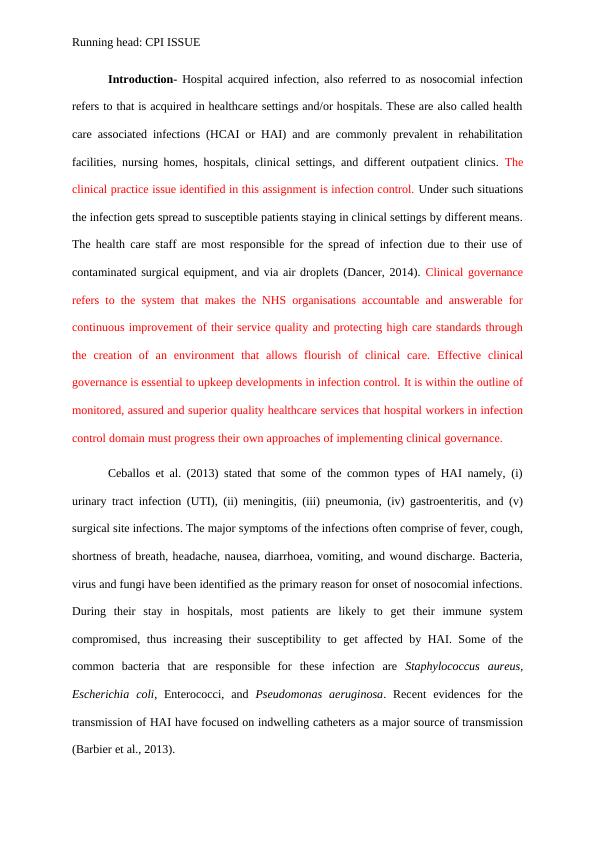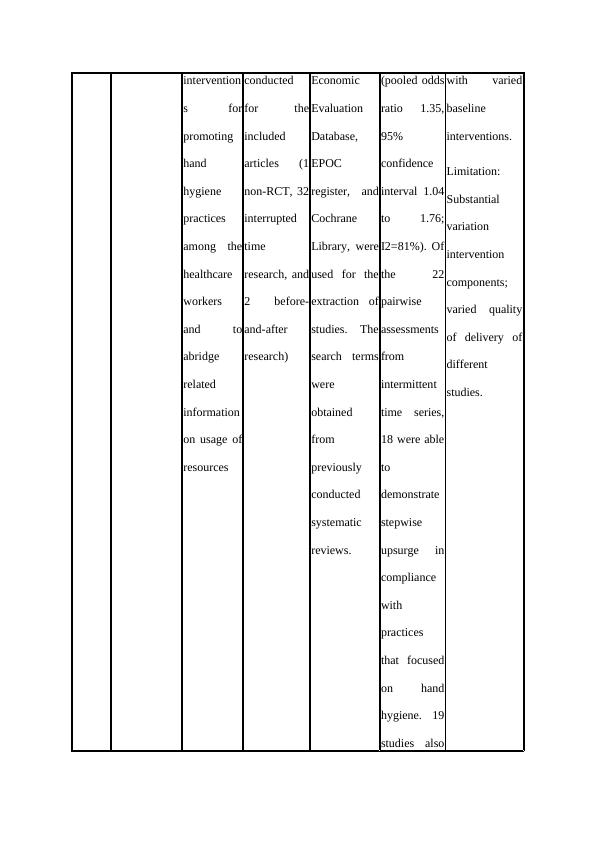NURS2006 - Chronic Illness and Nursing Care
Added on 2021-09-13
12 Pages2694 Words68 Views
Running head: CPI ISSUE
Introduction- Hospital acquired infection, also referred to as nosocomial infection
refers to that is acquired in healthcare settings and/or hospitals. These are also called health
care associated infections (HCAI or HAI) and are commonly prevalent in rehabilitation
facilities, nursing homes, hospitals, clinical settings, and different outpatient clinics. The
clinical practice issue identified in this assignment is infection control. Under such situations
the infection gets spread to susceptible patients staying in clinical settings by different means.
The health care staff are most responsible for the spread of infection due to their use of
contaminated surgical equipment, and via air droplets (Dancer, 2014). Clinical governance
refers to the system that makes the NHS organisations accountable and answerable for
continuous improvement of their service quality and protecting high care standards through
the creation of an environment that allows flourish of clinical care. Effective clinical
governance is essential to upkeep developments in infection control. It is within the outline of
monitored, assured and superior quality healthcare services that hospital workers in infection
control domain must progress their own approaches of implementing clinical governance.
Ceballos et al. (2013) stated that some of the common types of HAI namely, (i)
urinary tract infection (UTI), (ii) meningitis, (iii) pneumonia, (iv) gastroenteritis, and (v)
surgical site infections. The major symptoms of the infections often comprise of fever, cough,
shortness of breath, headache, nausea, diarrhoea, vomiting, and wound discharge. Bacteria,
virus and fungi have been identified as the primary reason for onset of nosocomial infections.
During their stay in hospitals, most patients are likely to get their immune system
compromised, thus increasing their susceptibility to get affected by HAI. Some of the
common bacteria that are responsible for these infection are Staphylococcus aureus,
Escherichia coli, Enterococci, and Pseudomonas aeruginosa. Recent evidences for the
transmission of HAI have focused on indwelling catheters as a major source of transmission
(Barbier et al., 2013).
Introduction- Hospital acquired infection, also referred to as nosocomial infection
refers to that is acquired in healthcare settings and/or hospitals. These are also called health
care associated infections (HCAI or HAI) and are commonly prevalent in rehabilitation
facilities, nursing homes, hospitals, clinical settings, and different outpatient clinics. The
clinical practice issue identified in this assignment is infection control. Under such situations
the infection gets spread to susceptible patients staying in clinical settings by different means.
The health care staff are most responsible for the spread of infection due to their use of
contaminated surgical equipment, and via air droplets (Dancer, 2014). Clinical governance
refers to the system that makes the NHS organisations accountable and answerable for
continuous improvement of their service quality and protecting high care standards through
the creation of an environment that allows flourish of clinical care. Effective clinical
governance is essential to upkeep developments in infection control. It is within the outline of
monitored, assured and superior quality healthcare services that hospital workers in infection
control domain must progress their own approaches of implementing clinical governance.
Ceballos et al. (2013) stated that some of the common types of HAI namely, (i)
urinary tract infection (UTI), (ii) meningitis, (iii) pneumonia, (iv) gastroenteritis, and (v)
surgical site infections. The major symptoms of the infections often comprise of fever, cough,
shortness of breath, headache, nausea, diarrhoea, vomiting, and wound discharge. Bacteria,
virus and fungi have been identified as the primary reason for onset of nosocomial infections.
During their stay in hospitals, most patients are likely to get their immune system
compromised, thus increasing their susceptibility to get affected by HAI. Some of the
common bacteria that are responsible for these infection are Staphylococcus aureus,
Escherichia coli, Enterococci, and Pseudomonas aeruginosa. Recent evidences for the
transmission of HAI have focused on indwelling catheters as a major source of transmission
(Barbier et al., 2013).

Contact transmission is the most frequent mode of transfer of nosocomial infections
through direct contact between an infected person and a healthy person, or with contaminated
hands and medical instruments. This calls for the need to place a due focus on hand hygiene
techniques. Medical hand hygiene is a broad term that refers to hygiene practices that are
linked to medical procedures. Hand washing prior to the administration of medicine or care
services has the potential of preventing or minimizing the spread of infection by cleansing the
hands of different pathogens (Schumacher et al., 2013). This assignment will summarise
three pieces of scholarly literature on hand hygiene practices and will critically evaluate their
content.
Summary table
Article
s
Author/s
(year)
Country
Aims Sample/
setting
Design/
methods
Main
findings
Strengths and
limitations of
the paper
1 (Luangasanati
p et al.,
2015)/Thailan
d
To assess
the
comparativ
e
effectivenes
s of the
WHO 2005
campaign
(WHO-5)
and
different
Systematic
review that
retrieved
3639 articles,
of which
only 41 were
able to meet
the inclusion
criteria.
Meta-
analysis
Electronic
databases
such as,
Embase,
CINAHL,
Medline,
NHS Centre
for Reviews
and
Disseminatio
n, NHS
Meta-
analysis of
two RCTs
indicated
that adding
the goal
settings to
WHO-5 was
related with
enhanced
acquiescence
Strength: The
networked
meta-analysis
allowed the
quantification
of comparative
effectiveness
among
sequence of
several
interventions
through direct contact between an infected person and a healthy person, or with contaminated
hands and medical instruments. This calls for the need to place a due focus on hand hygiene
techniques. Medical hand hygiene is a broad term that refers to hygiene practices that are
linked to medical procedures. Hand washing prior to the administration of medicine or care
services has the potential of preventing or minimizing the spread of infection by cleansing the
hands of different pathogens (Schumacher et al., 2013). This assignment will summarise
three pieces of scholarly literature on hand hygiene practices and will critically evaluate their
content.
Summary table
Article
s
Author/s
(year)
Country
Aims Sample/
setting
Design/
methods
Main
findings
Strengths and
limitations of
the paper
1 (Luangasanati
p et al.,
2015)/Thailan
d
To assess
the
comparativ
e
effectivenes
s of the
WHO 2005
campaign
(WHO-5)
and
different
Systematic
review that
retrieved
3639 articles,
of which
only 41 were
able to meet
the inclusion
criteria.
Meta-
analysis
Electronic
databases
such as,
Embase,
CINAHL,
Medline,
NHS Centre
for Reviews
and
Disseminatio
n, NHS
Meta-
analysis of
two RCTs
indicated
that adding
the goal
settings to
WHO-5 was
related with
enhanced
acquiescence
Strength: The
networked
meta-analysis
allowed the
quantification
of comparative
effectiveness
among
sequence of
several
interventions

intervention
s for
promoting
hand
hygiene
practices
among the
healthcare
workers
and to
abridge
related
information
on usage of
resources
conducted
for the
included
articles (1
non-RCT, 32
interrupted
time
research, and
2 before-
and-after
research)
Economic
Evaluation
Database,
EPOC
register, and
Cochrane
Library, were
used for the
extraction of
studies. The
search terms
were
obtained
from
previously
conducted
systematic
reviews.
(pooled odds
ratio 1.35,
95%
confidence
interval 1.04
to 1.76;
I2=81%). Of
the 22
pairwise
assessments
from
intermittent
time series,
18 were able
to
demonstrate
stepwise
upsurge in
compliance
with
practices
that focused
on hand
hygiene. 19
studies also
with varied
baseline
interventions.
Limitation:
Substantial
variation
intervention
components;
varied quality
of delivery of
different
studies.
s for
promoting
hand
hygiene
practices
among the
healthcare
workers
and to
abridge
related
information
on usage of
resources
conducted
for the
included
articles (1
non-RCT, 32
interrupted
time
research, and
2 before-
and-after
research)
Economic
Evaluation
Database,
EPOC
register, and
Cochrane
Library, were
used for the
extraction of
studies. The
search terms
were
obtained
from
previously
conducted
systematic
reviews.
(pooled odds
ratio 1.35,
95%
confidence
interval 1.04
to 1.76;
I2=81%). Of
the 22
pairwise
assessments
from
intermittent
time series,
18 were able
to
demonstrate
stepwise
upsurge in
compliance
with
practices
that focused
on hand
hygiene. 19
studies also
with varied
baseline
interventions.
Limitation:
Substantial
variation
intervention
components;
varied quality
of delivery of
different
studies.

reported
certain
clinical
outcomes
that were
dependable
on clinically
significant
decreases in
infection
rates,
ensuing
from
enhanced
hand
hygiene for
certain
hospital
pathogens.
2 (Rodriguez et
al., 2015),
Buenos Aries
To
determine
the
consequenc
e of
11 intensive
care units
(ICUs) from
Buenos
Aries,
Quantitative
study that
comprised of
a multimodal
intervention.
The study
recruited
705
contributors,
including
Strength:
Quantitative
research design
and
implementation
certain
clinical
outcomes
that were
dependable
on clinically
significant
decreases in
infection
rates,
ensuing
from
enhanced
hand
hygiene for
certain
hospital
pathogens.
2 (Rodriguez et
al., 2015),
Buenos Aries
To
determine
the
consequenc
e of
11 intensive
care units
(ICUs) from
Buenos
Aries,
Quantitative
study that
comprised of
a multimodal
intervention.
The study
recruited
705
contributors,
including
Strength:
Quantitative
research design
and
implementation

End of preview
Want to access all the pages? Upload your documents or become a member.
Related Documents
Training and Education of Hand Hygiene among Nursing Professionals to Reduce Hospital Acquired Infectionlg...
|12
|3083
|158
Nosocomial Infection - Causes, Types, Prevention and Treatmentlg...
|5
|574
|348
Hand Washing Among Health Care Professionals Case Study 2022lg...
|4
|1075
|33
Leadership in Preventing Nosocomial Infectionlg...
|12
|2936
|421
A critical analysis of knowledge gaps in hand hygiene among nursing professionalslg...
|10
|2611
|471
Efficacy of Alcohol-gel as a Substitute for Soap and Water Hand in a Clinical Settinglg...
|11
|2884
|214
